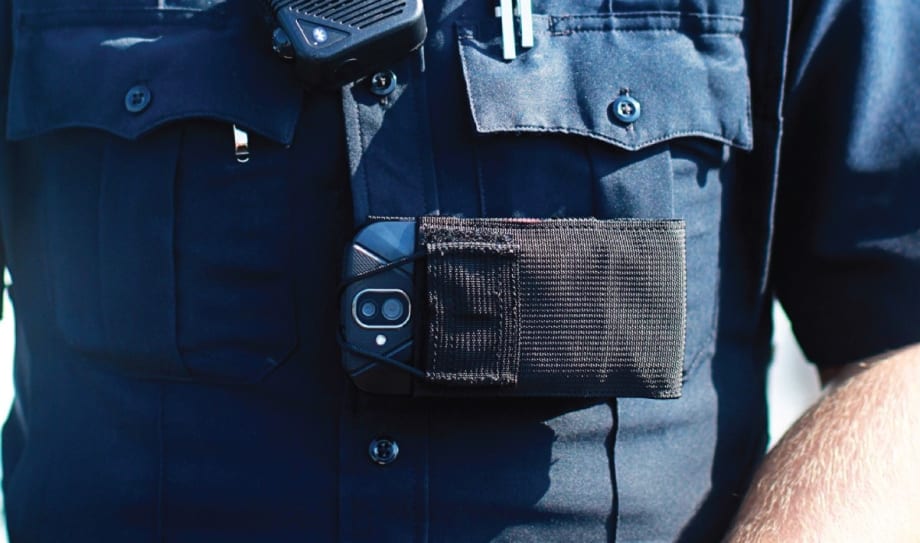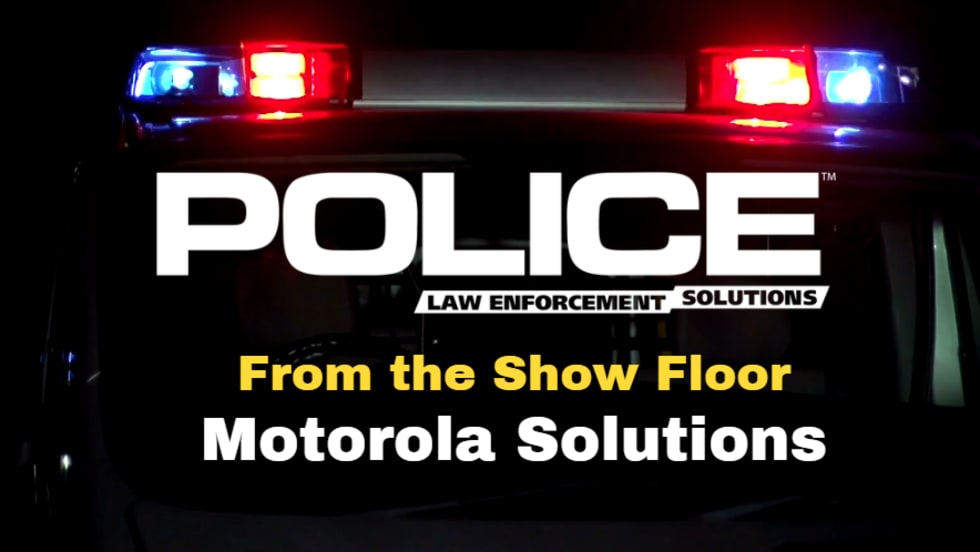In the line of duty, situational awareness is of the utmost importance for responding officers, their supervisors, and their commanding officers. Knowing an officer’s real-time position and status in the field can determine an effective response and sometimes be the difference between life and death if that officer needs immediate backup or is injured. There are many ways that agencies track the location of their officers in the field, one of them is through mobile devices such as smartphones and body worn cameras.
My Technology Can: Transform Smartphones Into Multiple Police Tools
Versaterm’s Visual Labs software gives a smartphone the capabilities of a body-worn camera and other critical devices.

Versaterm's Visual Labs software converts a smartphone into a body-worn camera.
Versaterm Public Safety
BWCs have become essential tools for police departments and staff in enhancing situational awareness and evidence-collection processes. However, body cameras are now just one of many pieces of equipment that officers are expected to have on them in the field. From cameras and handcuffs to conducted electric weapons like TASERs, and handheld radios, these tools, along with a duty belt and vest, can add over 20 pounds of weight that an officer must carry on the job. Captured footage after an incident then needs to be uploaded, processed and archived back at the station, which can lead to a delay in delivering justice for community members.
In today’s age of mobile technology, smartphones can offer respite as a single device offering video recording, live streaming, location tracking and cloud connectivity.
All-in-One Solution
Versaterm’s Visual Labs software transforms an officer’s department-issued Android smartphone into a body-worn camera with real-time video and audio streaming capabilities, with additional applications for in-vehicle and interview-room camera use cases.
Visual Labs enables agency supervisors in the field and dispatchers and other emergency communicators to remotely access the officer’s live video feed and GPS location for greater communication, coordination, and situational awareness during an incident. In addition to managing an effective response, the live video feed can prove critical to ensuring officer safety if the command center cannot establish verbal contact with a responding unit in the field.
In addition to streamlining the amount of equipment an officer needs to carry, Visual Labs also eliminates the need for docking stations and costly infrastructure upgrades for uploading the captured video, like with traditional body-worn and in-vehicle video systems. Officers can upload all footage from their phones over a cellular network or Wi-Fi connection for use in post-incident analysis, investigations and court proceedings.
Moreover, Visual Labs installation is simple. Officers simply download the application to their issued mobile device while all settings and configurations are remotely managed by the agency administrator, making the solution scalable and cost-effective.
Digital Evidence Management
All video, audio and photos captured from an incident using the Visual Labs BWC solution are uploaded to the cloud through a secure connection to the Visual Labs Digital Evidence Management system. The CJIS-compliant, cloud-secure, web-based system empowers agencies to manage their digital evidence without needing large on-premises servers and storage systems. Law enforcement personnel and investigators can easily search, tag, and annotate captured camera footage, with customized retention schedules and metadata such as case numbers and classifications. These capabilities help automatically track the chain of custody for more effective investigations.
The software also makes it easy to redact the recordings, blur faces or objects, or mute audio before requested footage is released into the public record. Simultaneous playback of multiple recordings and advanced location-based analytics, including heatmaps of officer coverage, provide an accurate account of events for investigators or detectives when reviewing or presenting case evidence.
In the Field
Visual Labs has been implemented at police agencies throughout the United States and Canada, including an agency in the Midwest.
In this Midwestern agency’s search for a body camera system, it sought a multi-functional tool that could also provide audio recording, personnel location tracking, and backup communications to allow its deputies to carry less equipment.
Visual Labs offered the agency a connected all-in-one solution without additional hardware or docking stations. Courtroom-ready evidence is captured in the forms of body-worn camera video, still images, and audio recordings. The footage is securely and automatically uploaded from the field to the Visual Labs Digital Evidence Management System where it can be accessed minutes after the incident. With Visual Labs, the agency has saved costs by discontinuing separate cameras and audio recorders and abandoning burning evidence onto CDs.
Additionally, Visual Labs saves the agency in overall costs by combining the Android application with an advanced web-based backend. A flat monthly rate per device for the entire service includes CJIS-compliant cloud storage of footage; an interface for annotating, tagging and sharing footage; and the use of the Android application.
For police agencies wanting to future-proof their camera programs, Visual Labs harnesses the connectivity, computational power, and advanced camera quality of today’s smartphones to aid in incident response and evidence collection.
With Visual Labs, agencies have the flexibility to choose from a wide range of hardware options, avoiding the constraints of proprietary devices with extended upgrade cycles. This freedom allows them to select the best-fit hardware for their needs, empowering them with diverse choices beyond the limitations imposed by a single hardware vendor. Customers can take advantage of rapid advancements in hardware and software technology with the assurance that they will always have a state-of-the-art body camera solution.
Visual Labs software offers a significant opportunity for device consolidation and leveraging rapid advancements in hardware and software technology to meet the needs of modern policing.
Visual Labs is part of the Versaterm ecosystem with purposeful integrations for every step of the public safety spectrum. Versaterm delivers intuitive tools developed for public safety agencies, forensic labs, court systems, schools, and other institutions. Its selective growth strategy focuses on improving customer and user workflows for more efficient and effective operations, leading to better service and more just outcomes.
Rohan Galloway-Dawkins is the chief product officer at Versaterm Public Safety. Before joining Versaterm, Galloway-Dawkins started his career at Motorola in 2005, and was instrumental in developing Motorola’s Command Central public safety solutions and driving the company’s shift toward software-centric operations.
More Technology

Flock Safety and Coreforce Partner to Enhance Real-Time Awareness and Operational Efficiency for Law Enforcement
A new integration partnership will enable Flock Safety hotlist alerts and license plate recognition (LPR) searches directly in Coreforce’s Real-Time Crime Center (RTCC) and Digital Evidence Management System (DEMS) platform.
Read More →
From the Show Floor: DroneSense by Versaterm
Learn about DroneSense by Versaterm as POLICE talks with Ryan Bracken, head of product. He explains the rapid advancements in drone technology, capabilities, and software.
Read More →
From the Show Floor: Versaterm
Learn more about Versaterm as POLICE visits with Rohan Galloway-Dawkins, chief product officer, to explore the company’s focus on a purpose-built platform for public safety.
Read More →
From the Show Floor: Motorola Solutions
In this video, learn about the Motorola Solutions ecosystem and how it provides tools that enhance the efficiency and safety of police officers. You’ll hear about the APX NEXT radio and SVX system, Assisted Narrative, and more.
Read More →
Learning How to Manage Your Fleet?
Watch this tutorial on how fleet management platforms work. You’ll see how easily you can integrate fleet telematics, dash cameras, and asset management in a single pane of glass and manage your fleet more effectively.
Read More →
From the Show Floor: Semtech
Learn about the latest ruggedized routers designed for public safety vehicles as POLICE visits with Greg Hill of Semtech. These routers are equipped with the latest 5G technology.
Read More →
Genetec Showcases Its Latest Public Safety Innovations at IACP 2025
Genetec demonstrated its Cloudrunner, Citigraf, and Clearance during IACP 2025 to show how they can provide law enforcement with a unified situational awareness to make cities safer.
Read More →
Ohio’s Statewide Drone First Responder Program to Take Flight
Over the next two years, the Ohio DFR Pilot Program will equip municipalities with advanced drone systems, deliver comprehensive training for first responders, and enable FAA-approved Beyond Visual Line of Sight operations.
Read More →
Tampa Police Department Deploys More Than 950 5G Smartphones
Tampa Police Department has deployed more than 950 5G-enabled smartphones through Verizon Frontline to support its Connected Officer initiative and enhance field communications.
Read More →
Getac Introduces F120 Rugged Tablet and V120 Rugged Laptop
The new devices feature larger displays, AI-ready processors, and enhanced durability for police and first responders working in demanding environments.
Read More →
